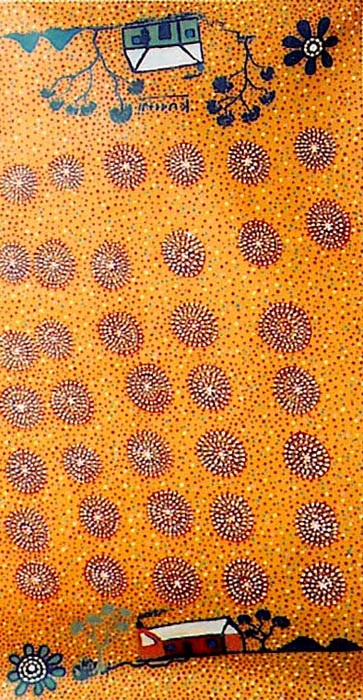Kubbitji (Kudditji) KNGWARREYE - Emu Dreaming (My House)
ADG: 355
DescriptionEmu Dreaming (My House), 1994
Story of painting
Custodian of his country, situated approximately 250kms north-east of Alice Springs, Kubbitji Kngwarreye is the younger brother of the internationally acclaimed artist, the late Emily Kame Kngwarreye (b.c.1918–1996). Yam Seeds are abundant at Alhalkere, and form a valuable addition to the Emus diet. Kubbitji is custodian of this Emu Dreaming story. In this painting, Kubbitji has rotated the canvas to depict both the front and back view of his house located at Atneltyeye (Boundary Bore), Utopia Homelands in the Northern Territory.
Kubbitji (Kudditji) KNGWARREYE - Biography
Born c. 1928
Language Eastern Anmatyerre
Community Atneltyeye Boundary Bore, Utopia
Country Utopia Homelands. N.T.
Region Central Australia
Stories Emu Dreaming, Yam (Seed) Dreaming, My Country, Men’s Ceremonies
Kubbitji Kngwarreye, like many Utopia artists, was initially employed as a stockman, and began painting in the early 1980s. As Custodian of his country on the northern boundary of the Utopia Homelands, Kubbitji painted interpretations of the Emu Dreaming sites and the ceremonies associated with Men’s Business (Initiation Ceremonies) and Ancestral Dreamings, using precise dots, and featuring meticulously painted circles of dots on a chequered or dotted background. About the year 2000, Kubbitji's work became far looser and more 'abstract', and his work was then likened to his sister Emily Kngwarreye’s final works, with wide brush strokes.
By 2003 Kubbitji began to explore a looser painting style. Using a heavily loaded paint brush, and often mixing solid colours on the canvas, Kubbitji was able to accentuate the landscape of his home country. As a stockman, living under the stars, Kubbitji knew every inch of his desert country and its wide open spaces. He had experienced the shimmering desert heat, the sudden flooding rains and the brilliance of the night sky, living far removed from civilisation.
Kubbitji’s new paintings now have several styles, where Kubbitji explores the size of his canvas, as well as creating a sense of the immense space of the desert in his paintings. He uses massive blocks of stippled colour, sometimes with only two colours, while in other paintings a quilt of juxtaposed colours produces a landscape effect. Many writers have likened Kubbitji’s paintings to the work of the American artist, Marcus Rothko.
Achievements
In 2007 Kubbitji was named one of the 50 most collectable artists in Australia.
Solo Exhibitions
2005 - New Paintings, Vivien Anderson Gallery, Melbourne
2005 - Colours in Country, Art Mob, Hobart, Tasmania
2004 - My Country, New Paintings. Vivien Anderson Gallery, Melbourne
2004 - My Country, Japingka Gallery, Perth
Collections
Araluen Art Centre, Alice Springs
RM Barokh, Los Angeles, California
Macquarie University, Sydney
Hank Ebes Collection, Melbourne
Bibliography
Bardon, Geoffrey & Bardon, James: Papunya: A Place made after the story, (Miegunyah Press, 2004)
Kleinert, Sylvia & Neale, Margo: The Oxford Companion to Aboriginal Art and Culture, Oxford University Press, Melbourne, 2000
Kreczmanski, Janusz B & Birnberg, Margo: Aboriginal Artists: Dictionary of Biographies: Central Desert, Western Desert and Kimberley Region. 2004
Ranking - Most Important Australian Indigenous Artists (both living and deceased)
2011 Ranked 131/200

